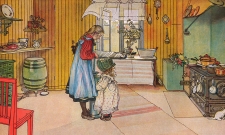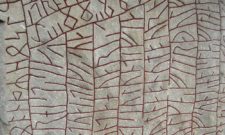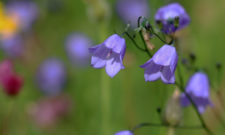Shop our historical maps
Culture
Crispbread - an indispensable part of Swedish food culture

Feb
Knäckebröd (also known as stove bread) is a fermented hard bread that originated in Sweden. Join Malin Kim as she explores the history of crispbread.
We know for sure that crispbread was part of the Swedish diet already in the Middle Ages. According to some sources (including Wikipedia), crispbread has been baked in present-day Sweden since the 5th century, but I suspect this is a hoax created by dropping the number 1 from "16th century" in a source material that has since been reused.
In the 5th century, rye was hardly found in Sweden, but the dominant cereal was barley. In any case, we can say that our ancestors have been nibbling crispbread for hundreds of years.
The crispbread originated in Värmland, but quickly spread to large parts of the country. As a rule, crispbread is baked from just four ingredients: unsifted rye flour, yeast or sourdough, salt and water. The bread is formed into thin, flat cakes, which are baked quickly at a high temperature. It is usually given a hole pattern using a bread knife or crispbread slicer.
The crispbread gets its name from the fact that in older times it was treated with a crushed cracker or breadcrumb, to make it easier to break into pieces. Traditionally, crispbread also has a large hole in the middle, which is due to the fact that crispbread was a storage bread that was hung on drying racks.
For the Swedish bread culture in large parts of old Sweden, hard or dry, fermented rye bread or rye mix bread are particularly characteristic. These breads, referred to above (p. 177) under the name of stove bread or cracker bread, are round and provided with holes for string or bread sticks. They are folded and rolled out with a view to being hung up to dry without breaking or folding too much. This means that they can be made about 30-40 cm in diameter and about ½ - 2 cm thick. The loaves are cracked with crunch and are usually gnawed or pecked on one side only.
From the ethnologist Åke Campbell's book "The Swedish Bread" from 1950
Due to its low liquid content, it has a very good shelf life, which was particularly important in the old peasant society. In his book History of the Nordic peoples, published in 1555, Olaus Magnus wrote that bread baked at the birth of a child could last until the child's betrothal.

The first crispbread bakeries appeared in the mid-19th century and nowadays most of the Swedish crispbread consumption is baked industrially. Swedes eat 4-5 kg of crispbread per person per year, which is more than any other population. 85% of Swedish households have crispbread at home, compared to, for example, 45% in Germany and 8% in France. Crispbread has also become one of Sweden's most exported foods.
In modern times, crispbread has started to be produced in new varieties. In some cases, fine rye flour is mixed into the dough and pure wheat crackers are also used, as well as crispbread flavoured with seeds or spices. Round cakes have also been joined by square and oblong shapes. Common toppings include butter, hard cheese, liver pâté, caviar and spicy sausage. Crispbread is a popular accompaniment to pea soup and herring dishes and is considered an integral part of Swedish cuisine. Without exaggeration, it could be said to be something of a national bread.
Print sources:
Törnblom, Marie et al. (2012), Bread from near and far, Grenadine Book Publishing
Unprinted sources:
Print sources:
Törnblom, Marie et al. (2012), Bröd från när och fjärran, Grenadine bokförlag
Unprinted sources:
http://danskan.se/historia/svenska-brodets-historia
http://www.gp.se/livsstil/mat/alla-%C3%A4lskar-kn%C3%A4ckebr%C3%B6d-1.5193
http://www.hejdeknacke.se/?file=om-hejde-knaecke/knaeckebroedets-historia
http://knackebrodsakademin.se/knackebrod/
https://sv.wikipedia.org/wiki/Kn%C3%A4ckebr%C3%B6d
http://svensktuppfinnaremuseum.se/knackebrod/
Originally published on Cultural memory.
Subscribe to YouTube:
If you appreciate Allmogens independent work to portray our fine Swedish history and Nordic culture, you are welcome to buy something nice in the shop or support us with a voluntary donation. Thank you in advance!
Support Allmogens via Swish: 123 258 97 29
Support Allmogens by becoming a member
Support Allmogens in your will
Popular
The slaughter of the almages on Helgeandsholmen 1463
Allmoge - what is it?
Smokestone (Eye 136)
Culture
The plague in the Gullspång river
25 March 1644: Massacre of Scanian peasants at the Battle of Borst
Speech on Swedish Flag Day
How to renovate old windows step by step
Small bluebell voted Sweden's national flower








